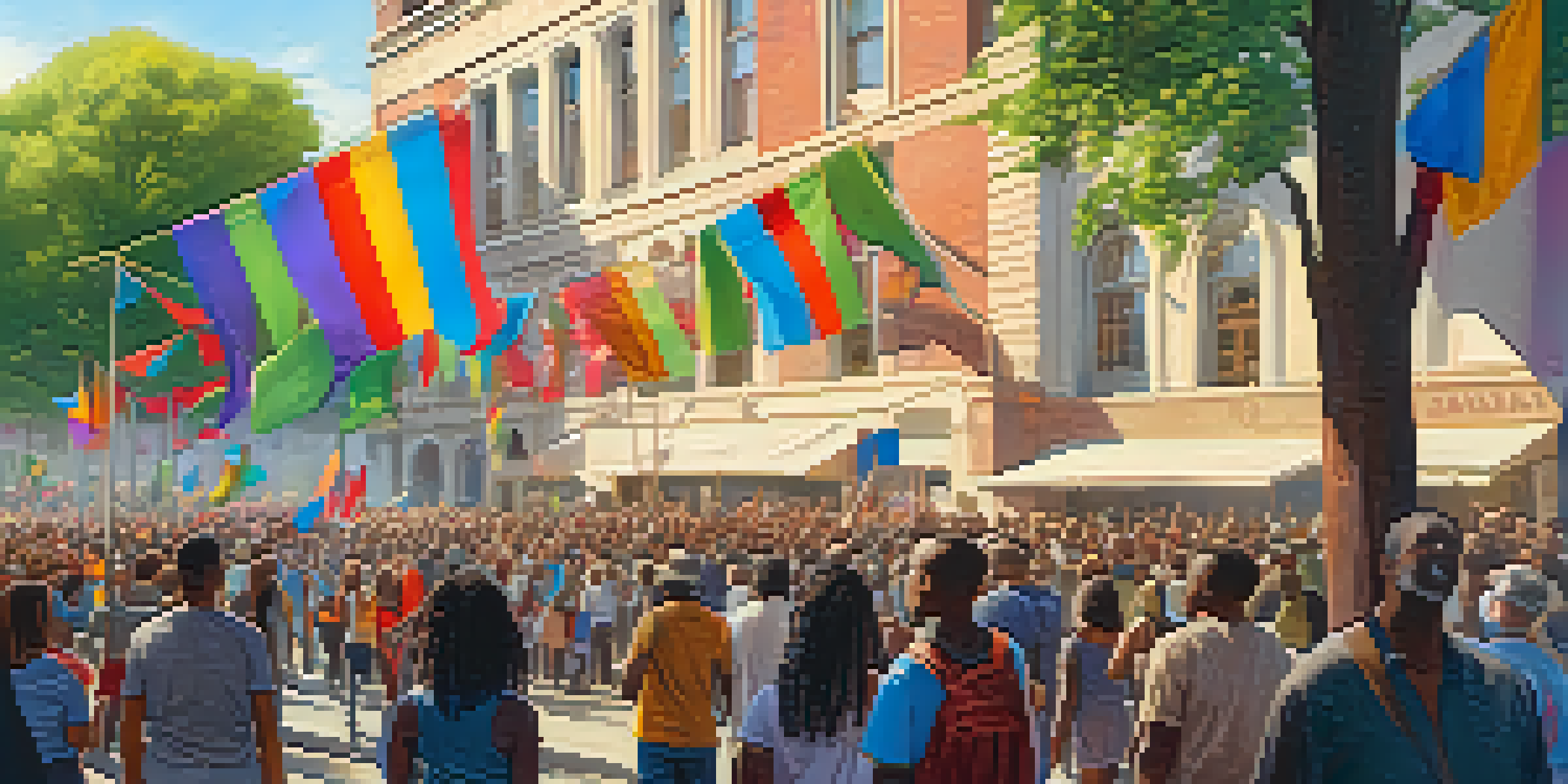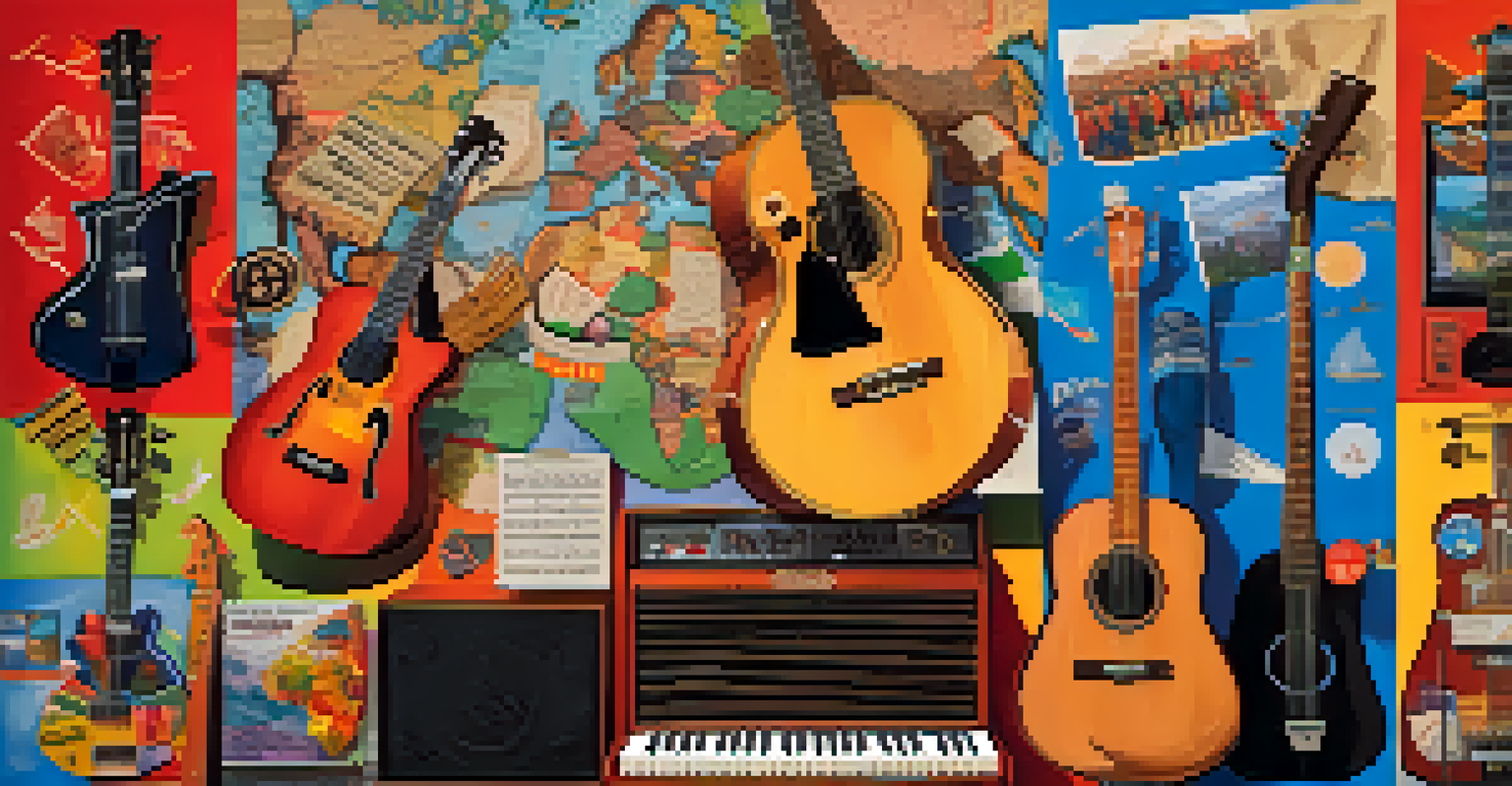The Intersection of Music and Politics in Global Protests

Music as a Form of Resistance in Protests
Throughout history, music has served as a powerful tool for resistance. From folk songs to rap anthems, melodies have given voice to the struggles of the oppressed. For example, during the Civil Rights Movement in the United States, songs like 'We Shall Overcome' became anthems of hope and unity.
Music can change the world because it can change people.
When people gather to protest, the right music can uplift spirits and foster a sense of community. It can transform a collection of individuals into a cohesive movement, reminding them that they are not alone in their fight. This emotional connection can amplify their resolve.
Moreover, music can capture the essence of the moment, turning complex emotions into relatable experiences. In many cases, songs written in response to political unrest resonate across borders, showcasing the universal nature of human struggles.
Historical Examples of Music in Political Movements
Looking back through history, we can find countless examples of music playing a pivotal role in political movements. For instance, during the anti-apartheid struggle in South Africa, musicians like Miriam Makeba and Hugh Masekela used their platforms to rally support and raise awareness about the injustices faced by their people.

Similarly, the protest songs of the 1960s, such as Bob Dylan's 'The Times They Are A-Changin',' captured the spirit of a generation fighting for civil rights and against the Vietnam War. These songs not only inspired but also provided a soundtrack to the collective consciousness of a time.
Music Unites for Social Change
Throughout history, music has served as a powerful tool for resistance, bringing people together during protests and amplifying their collective voices.
These historical instances remind us how music can serve as both a catalyst for change and a means of documenting struggles. As we reflect on these moments, we see the profound impact that music can have on political landscapes.
The Role of Social Media in Spreading Protest Music
In today's digital age, social media has revolutionized the way protest music spreads. Platforms like Twitter, Instagram, and TikTok enable artists to share their messages with a global audience in real-time. This access allows protest songs to reach people who may not have otherwise encountered them.
The power of music makes all the difference. It can heal, inspire, and unify people in ways that words alone cannot.
Moreover, viral challenges and hashtags can create a sense of urgency and connection among users. For instance, the 'I Can't Breathe' challenge on TikTok not only highlighted issues of police brutality but also incorporated music as a form of solidarity and remembrance.
As a result, social media acts as a modern amplifier for the voices of the disenfranchised, making it easier for music to inspire action and solidarity across diverse groups. This dynamic landscape has changed how we perceive and engage with protest music.
The Emotional Power of Music in Protests
Music can evoke powerful emotions, making it an effective tool for rallying support during protests. When individuals sing or chant together, they experience a sense of unity and shared passion that can be deeply moving. This emotional bond can strengthen their resolve and motivate them to continue fighting for their cause.
For instance, during the 2019 protests in Hong Kong, the song 'Glory to Hong Kong' became an anthem for demonstrators. The emotional weight of the lyrics resonated with the people's desire for freedom and democracy, creating a shared experience that transcended language barriers.
Social Media Amplifies Protest Tunes
In today's digital age, social media platforms enable protest music to reach global audiences, fostering connection and urgency among activists.
Ultimately, the emotional power of music in protests serves to humanize the struggle, reminding both participants and observers of the personal stakes involved. This connection can inspire empathy and understanding, fostering a more inclusive dialogue around important issues.
Cultural Differences in Protest Music Around the World
While music serves as a universal language in protests, cultural differences shape how it is expressed and received. Various regions have unique musical styles that reflect their histories and struggles, making each protest sound distinct. For example, in Latin America, cumbia and salsa often accompany social movements, blending rhythm with messages of resistance.
In contrast, in the Middle East, traditional instruments and folk melodies are often infused with contemporary lyrics that address current political issues. This blending of old and new creates a rich tapestry of protest music that resonates deeply with local audiences.
These cultural nuances remind us that while the message may be similar—a call for justice and change—the soundtrack can vary greatly, adding layers of meaning and identity to the movements.
The Future of Music in Political Activism
As we look to the future, the role of music in political activism will likely continue to evolve. With advancements in technology, artists have more tools than ever to create and share their messages. This can lead to innovative forms of protest music that resonate with younger generations who are increasingly engaged in social issues.
Additionally, collaborations across genres and cultures can spark new movements and ideas. When artists from different backgrounds come together, they can create powerful anthems that speak to a broader audience, reinforcing the idea that the fight for justice is a collective effort.
Cultural Diversity Shapes Protest Music
Cultural differences influence how protest music is expressed and received, creating distinct sounds that reflect the unique struggles of various regions.
Ultimately, the future of music in political activism holds the potential for greater inclusivity and creativity, ensuring that the voices of the marginalized are heard loud and clear.
Conclusion: The Lasting Impact of Music on Society
In conclusion, the intersection of music and politics in global protests highlights the enduring power of art as a catalyst for change. From historical movements to modern-day social media campaigns, music has consistently played a vital role in uniting individuals and amplifying their messages.
As we reflect on the impact of protest music, it's essential to recognize its ability to foster empathy and understanding among diverse audiences. The melodies and lyrics serve not just as expressions of resistance but as reminders of our shared humanity.

Looking ahead, we can expect music to continue evolving as a tool for activism, bridging gaps and inspiring future generations to join the fight for justice and equality.